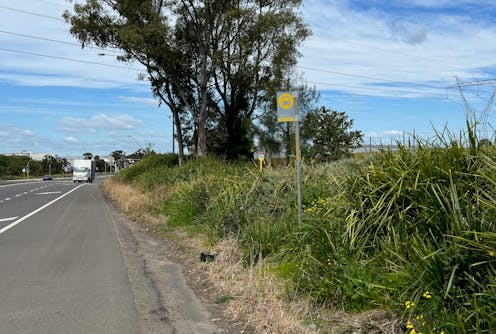Sydney’s shiny new Metro service is great – now can we fix the city’s busted bus stops?
- Written by Kurt Iveson, Professor of Urban Geography, University of Sydney

Multi-billion-dollar transport projects create headlines, and politicians love to bask in the glow of a successfully completed project such as Sydney’s new Metro. This service will change many people’s lives for the better.
In stark contrast with the shiny new Metro stations, the bus network is suffering from under-investment. Our survey of thousands of suburban bus stops, conducted with advocacy group Sweltering Cities, found many lack shelter, seating, signage and even stable surfaces.
Fixing Sydney’s busted bus stops might not grab headlines, but it will greatly improve access to our public transport network. It will also provide comfort and dignity for the many people who rely on buses. Sydneysiders make more than 600,000 bus trips every weekday.
Extreme heat and rain are becoming more frequent with climate change. This makes the task of providing bus riders with adequate shelter even more urgent.
The weakest link in the network
Transport network planners often think about bus stops as points along a route rather than places – they appear merely as dots on a network map.
But, for passengers, bus stops are public places in their neighbourhood. If they lack basic amenity such as shade, seating, signage and smooth surfaces, they become the “weakest link in the journey chain”, either discouraging or preventing people from using bus services. Transport researchers are increasingly recognising the importance of bus stop infrastructure for making buses accessible – especially for riders who have mobility or health issues.
In cities such as Atlanta and New York in the United States, organised groups of bus riders are agitating for improvements. They not only want to improve access, but also to combat the indignity of waiting for buses in places that offer them no care or protection.
Sydney’s busted bus stops
Buses are a vital element of metropolitan Sydney’s public transport. Some 37% of public transport trips in New South Wales are by bus.
But Sydney’s network of more than 20,000 bus stops leaves a lot to be desired. Their sorry state has led to a community campaign for improvements.
As part of Sweltering Cities’ “Busted Bus Stops” campaign, community members and University of Sydney urban geography students conducted a “bus stop census”. We documented the amenities at more than 2,500 bus stops in Sydney. Using a combination of Google Street View and in-person field visits, we mapped the stops with shelters or shade structures, seats and signage.
We focused our attention especially on the hottest suburbs in the west. It can be over 9°C hotter here than in the city’s east. Extremely hot days are also more frequent.
Exposure to extreme heat can have a range of harmful health effects. Some groups like children and older people are especially vulnerable.
What did the survey find?
Analysing this data, the Busted Bus Stops report revealed glaring problems and inequalities. For instance:
more than 60% of 105 bus stops mapped in the new growth area around Schofields in the north-west had no shelter, shade or seating
almost 70% of 596 bus stops mapped in and around Penrith, where temperatures have reached over 50°C in summer, had no shelter, shade or seating
in comparison, in the inner-west suburbs of Strathfield, Ashfield and Summer Hill, over 65% of 101 bus stops mapped had seating and shade or shelter.
Not surprisingly, passengers raised bus stop amenity as a key issue during consultations for the NSW government’s 2023 Bus Industry Taskforce report. Many Sydneysiders will be familiar with the experiences passengers shared – such as seeking shelter from the sun or rain by moving away from an unsheltered bus stop, only to then have the bus you are waiting for cruise right past.
Upgrades aren’t glamorous but make a huge difference
Reflecting the neglect of bus stops, Transport for NSW does not take responsibility for providing bus stop shelters, seating or surface works. Indeed, when we started our research, we asked Transport for NSW if they could share data about bus stop shelters and were told they didn’t collect it.
Responsibility for bus stop amenity falls mostly on cash-strapped local councils. This leads to unequal provision across the city.
Local councils in wealthy areas have more resources to provide bus shelters. They are also in a better position to strike deals with outdoor advertising companies to provide street furniture like bus stops.
Lower-income and hotter areas where good shelters are most needed are left behind. This is the case in Western Sydney’s 2770 postcode suburbs of Willmot, Lethbridge Park, Bidwill and Tregear. Residents there are calling for improvements to bus amenities and services.
These problems can be fixed. The City of Los Angeles recently started a major upgrade project to install 3,000 shelters and 450 shade structures at bus stops across the city over the next ten years. Priority locations are being identified through analysis of ridership data, along with equity and heat indexes. The goal is for 75% of all passengers to board buses from locations with a shelter.
It’s time for the NSW government to follow LA’s lead and launch a city-wide program of upgrades for Sydney’s neglected bus stops.
Investing in bus stops might be less glamorous than new mega-projects. But it’s a lot cheaper.
And, just like the new Metro, it would make a huge difference to the everyday lives of millions of Sydneysiders – especially the young, the old and others who are most vulnerable to heat and depend on buses because they don’t drive.
Authors: Kurt Iveson, Professor of Urban Geography, University of Sydney




